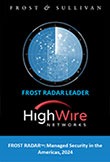Network security tools are growing in number and sophistication in order to respond to the cyber threatscape, which is growing equally as fast. This outmodes the idea of a single layer of protection, necessitating multiple tools, platforms and experts to adequately monitor network security. All of these people, tools, processes, software and hardware solutions serve as a network security hub known as a security operations center (SOC, pronounced “sock”). And every SOC follows a distinct set of operational guidelines known as a SOC framework.
SOC Framework Basics
SOC frameworks, whether created and operated in-house or outsourced, can be made up of a variety of technologies and tools, but they typically enable the following capabilities:
-
Monitoring
A SOC provides complete and consistent visibility into your network, enabling team members and/or technologies to identify anomalies and possible breaches. Automated tools using artificial intelligence (AI) and machine learning (ML) can aid in human analyst monitoring.
-
Analysis
A SOC analyzes each alert that is triggered to quickly determine if it is legitimate or a false alarm. Additionally, SOC reporting and analytics help administrators keep track of unauthorized use or misuse and proactively identify future internal and external threats.
-
Incident Response and Remediation
A SOC framework includes incident response and remediation components, enabling systematic (often fully automated) responses to security incidents. After the initial response, SOC technologies and experts can restore operations and analyze the cause and scope of the breach to mitigate future damage.
-
Auditing and Logging
A SOC is in a constant state of auditing and logging in order to:
-
- Uncover new or changing vulnerabilities
- Keep historical data points for analysis
- Serve as a critical piece of disaster recovery
- Help ensure industry-related or regulatory compliance
-
Threat Hunting
A SOC typically blends technology and human expertise to proactively search for impending threats and identify their origin, patterns, impact and entry points, in order to create the best defense.
Common SOC Frameworks
In addition to consisting of a typical set of capabilities, SOCs tend to follow cybersecurity frameworks made up of best practices and methodologies. Some common SOC frameworks are:
-
NIST
The NIST cybersecurity framework is published by the U.S. National Institute of Standards and Technology (NIST) and provides threat lifecycle management standards and guidelines to help organizations establish security strategies and improve key metrics. The five best practices associated with NIST are:
-
- Identify
- Protect
- Detect
- Respond
- Recover
-
MITRE ATT&CK
ATT&CK stands for Adversarial Tactics, Techniques and Common Knowledge. This framework, which was created by Mitre Corporation and released in 2013, focuses on studying adversarial behavior to formulate responses and new defense tactics.
-
Cyber Kill Chain
This framework, developed by Lockheed Martin, is built on the military concept of structuring an attack in response to your opponent’s strategies and vulnerabilities. Cyber Kill Chain is a staged approach, encompassing the following stages:
-
- Reconnaissance
- Intrusion
- Exploitation
- Privilege Escalation
- Lateral Movement
- Obfuscation
- Denial of Service
- Exfiltration
-
Unified Kill Chain
This framework merges the MITRE ATT&CK and Cyber Kill Chain frameworks to provide a more detailed approach to understanding the adversary and prioritizing risks. This framework expands the attack chain into an 18-phase analysis.
Types of SOC Services
Most businesses find that effective cybersecurity management is much more than their traditional IT team can handle. To address this growing need, organizations can use one of two main approaches to establishing a SOC – creating one in-house or outsourcing to a managed SOC provider.
-
In-house SOC
Companies might opt to build a SOC in-house, focusing on unifying security strategy and communications. While an in-house SOC might seem attractive for control and customization, it can prove challenging when it comes to cost, deployment, staffing and maintaining the latest cybersecurity technologies.
-
Managed SOC
With a managed SOC, companies can rely on a shared team of experts to monitor their networks 24/7/365. Outsourcing a SOC to a managed service provider (MSP) enables a business to access the most up-to-date cybersecurity technologies and a team of experienced analysts with no overhead and a very short rollout period.
The Future of SOC
The bottom line is this: bad actors and their technologies never rest. An effective SOC must be backed by constant monitoring, ongoing cyberthreat research, automated remediation, and a team of experts to oversee operations.
The future of SOC for businesses, MSPs and managed security services providers (MSSPs) alike is a fully outsourced SOC-as-a-Service solution like High Wire Networks’ Overwatch SOC. High Wire Networks’ managed SOC solution provides the following:
- Operations monitored by technology and humans 24/7/365.
- Cyberthreat blocking with Zero-Trust Secure Access Service Edge.
- Threat detection with AI-powered Open XDR.
- The ability to stop active cyberattacks with Security Orchestration, Automation and Response (SOAR).
- Expert security analysts to respond to alerts and proactively hunt for threats.
Combining all of these features with affordable, scalable pricing and High Wire Networks’ Overwatch Managed SOC can help businesses stay protected and help MSPs and MSSPs stay competitive.
Discover how Overwatch Managed SOC could work for you.
Contact a High Wire SOC Specialist today.
By David Barton, CTO at High Wire Networks
Meet the Expert
 David Barton is Chief Technology Officer at High Wire Networks. He oversees High Wire technology solutions and leads the sales engineering teams for High Wire’s Overwatch Managed Security Marketplace, which enables partners to deliver comprehensive cybersecurity that’s easy to sell and easy to buy via affordable subscription. Barton has more than 20 years of cybersecurity experience with companies in various industries, including telecommunications, health care, software development, finance, mortgage, and government. He’s also the former CISO for Stellar Cyber, the company behind the open-XDR solution that Overwatch leverages to deliver managed detection and response through its 24/7 Security Operations Center (SOC) as a Service.
David Barton is Chief Technology Officer at High Wire Networks. He oversees High Wire technology solutions and leads the sales engineering teams for High Wire’s Overwatch Managed Security Marketplace, which enables partners to deliver comprehensive cybersecurity that’s easy to sell and easy to buy via affordable subscription. Barton has more than 20 years of cybersecurity experience with companies in various industries, including telecommunications, health care, software development, finance, mortgage, and government. He’s also the former CISO for Stellar Cyber, the company behind the open-XDR solution that Overwatch leverages to deliver managed detection and response through its 24/7 Security Operations Center (SOC) as a Service.








